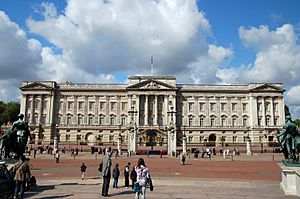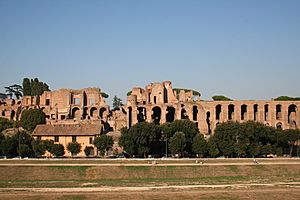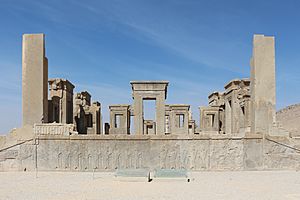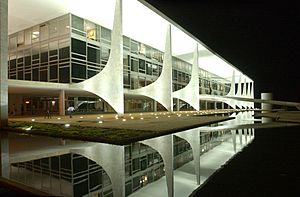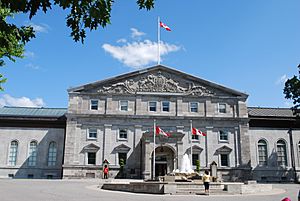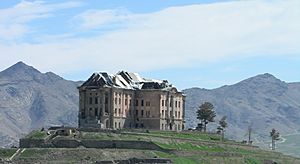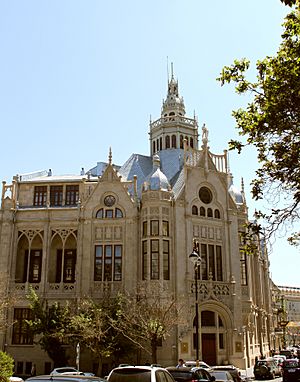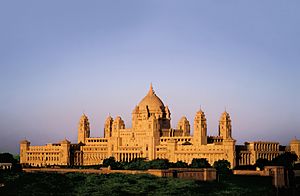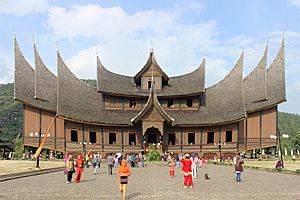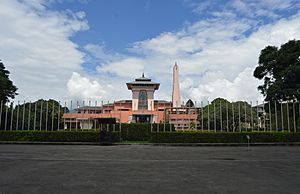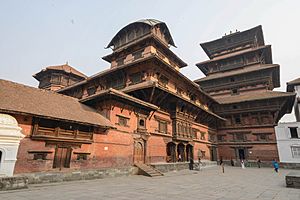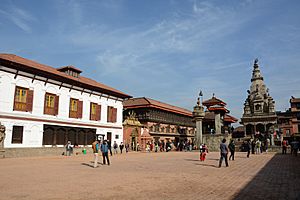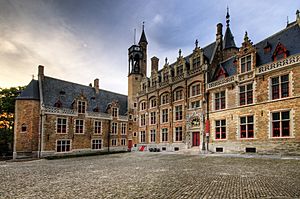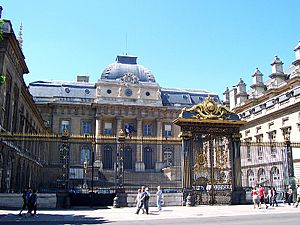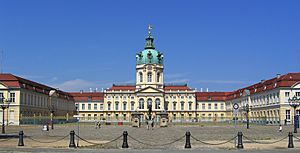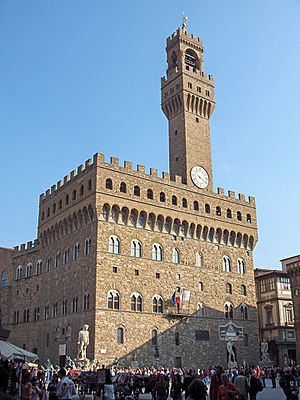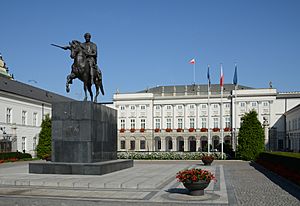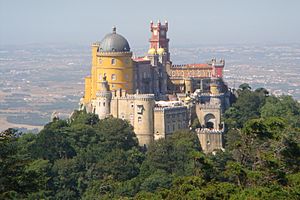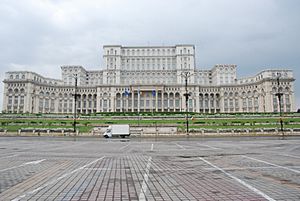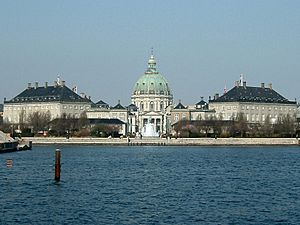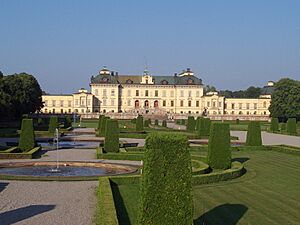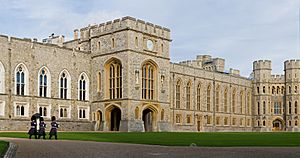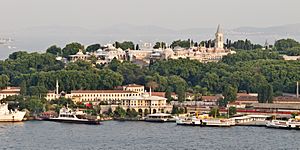Palace facts for kids
A palace is a really big and fancy house, often where a king, queen, or other important leader lives. Think of it as a super-sized home for someone in charge! The word "palace" comes from the Latin word Palātium, which was the name of a hill in Rome where the Roman emperors lived.
Many old palaces are now used for other things, like museums, hotels, or even government buildings. Sometimes, the word "palace" is also used for a very decorated building used for fun, like a movie theater.
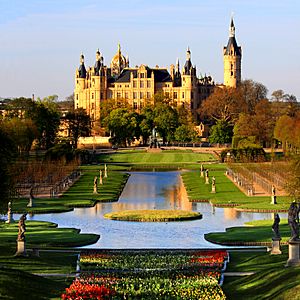


Contents
What Does "Palace" Mean?
The word palace comes from an old French word, palais, which means "imperial residence." This word came from the Latin Palātium, one of the seven hills of Rome. The first "palaces" on the Palatine Hill were where the Roman emperors lived. Even after Rome grew, the Palatine Hill remained a popular place for important people to live.
Over time, the word Palātium started to mean the emperor's home, not just the hill itself. In the Middle Ages, a "palace" could also mean the place where the government worked. For example, Charlemagne built 14 "palaces" across his empire, which were places for his government to operate from.
Today, historians use the term "palace" for large buildings that housed rulers, their courts, and their staff in ancient cultures. Informally, "palace" can mean any very grand home.
Ancient Palaces
Some of the oldest known palaces were the homes of the Egyptian Pharaohs in Thebes. These had large outer walls surrounding many buildings and courtyards. Other ancient palaces include those in Assyria (like Nimrud and Nineveh), the Minoan palace in Knossos, and the Persian palaces in Persepolis and Susa.
Palaces in East Asia, like those in Japan, Korea, Vietnam, Thailand, Indonesia, and China's Forbidden City, are often made up of many smaller buildings and pavilions surrounded by large, walled gardens. This is different from the single, large palace buildings often seen in Medieval Western Europe.
Palaces Around the World
Americas
Brazil
Brasília, Brazil's capital, has many modern palaces. Most were designed by the famous architect Oscar Niemeyer. The Alvorada Palace is where Brazil's president lives. The Planalto Palace is where the president works.
Rio de Janeiro, Brazil's old capital, also has many royal and imperial palaces. These include the Imperial Palace of São Cristóvão, which was the home of Brazil's emperors.
Canada
In Canada, official homes for the monarch and their representatives (like the Governor General) are called "Government House." The main home for the monarch and Governor General in Ottawa is called Rideau Hall. It's a large estate with about 175 rooms.
Another important official home is the Citadelle of Quebec, located in Quebec City. It's an old military building and part of the city's fortifications, which are a UNESCO World Heritage Site.
Mexico
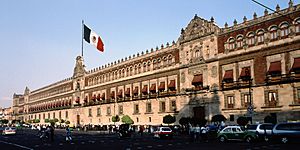
Mexico City is often called the "City of Palaces." This nickname was given by a traveler who visited in the 1800s. The Aztec emperors built many palaces in their capital, Tenochtitlan (now Mexico City).
The National Palace, or Palacio Nacional, is in Mexico City's main square. It was first built in 1563 and was once the home of the Spanish rulers. Today, it's the official seat of the government's executive branch.
Another famous palace in Mexico City is the Castillo de Chapultepec, or Chapultepec Castle. It's in the middle of Chapultepec Park and is now the Mexican National Museum of History. It's special because it's the only castle in North America that was lived in by emperors.
United States
In the United States, palaces include the White House, which is the official home of the President. There are also official homes for many governors and Catholic bishops. Some palaces that belonged to former rulers, like the Hawaiian Royal Family, still exist.
Examples include:
- ʻIolani Palace in Honolulu, Hawaii, which was home to Hawaiian monarchs.
- The Governor's Palace in Williamsburg, Virginia, a rebuilt home for the royal governors of Virginia.
- The Palace of the Governors in Santa Fe, New Mexico, which was home to Spanish and Mexican governors.
Some private mansions in the U.S. are so grand they feel like palaces, even if they aren't called that. Hearst Castle and the Biltmore Estate are good examples.
Uruguay
The Palacio Legislativo (Legislative Palace) is where the Uruguayan Parliament meets.
Asia
Afghanistan
Kabul, the capital of Afghanistan, has many palaces. Many were built in the 1800s. The Darul Aman Palace is one of the most famous. Sadly, many palaces were damaged during the civil war, but some have been repaired or rebuilt.
Azerbaijan
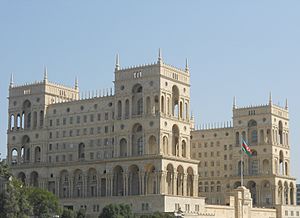
Azerbaijan has many palaces from different time periods. For example, the "Goyalp" Palace was built in the 1130s. The Baku Khans' Palace complex dates back to the 1600s.
The Palace of Happiness (Səadət Sarayı) in Baku is a beautiful historic building built in the early 1900s. The Palace of Shaki Khans in Shaki, Azerbaijan was a summer home built in 1797. It has amazing decorative tiles and stained-glass windows.
Azerbaijan's president has several official homes, including the Presidential Palace and Gulustan Palace in Baku.
Brunei
Istana Nurul Iman is the world's largest residential palace. It's the official home of the Sultan of Brunei, Hassanal Bolkiah, and where the Brunei government works. It's located near Bandar Seri Begawan, the capital.
China

A very famous Chinese palace is the Forbidden City. It was the imperial palace of China from the Ming Dynasty to the end of the Qing Dynasty. It's the largest palace complex in the world and is in the middle of Beijing. The Forbidden City shows off traditional Chinese palace design. Other examples include the Summer Palace in Beijing and Mukden Palace in Shenyang.
Chinese palaces are usually designed in a grid pattern with main buildings and many smaller pavilions, all surrounded by walls. They are not like one massive building, but rather many structures with parks and courtyards.
India

India has many palaces because of its long history with many different rulers. While some ancient buildings are now ruins, many medieval palaces are still in good shape. These palaces show the amazing skills of architects and engineers from long ago.
Many royal palaces in India are now museums or hotels, but some are still homes for members of old royal families. These grand buildings often have beautiful fountains, pools, fancy pillars, and decorative staircases.
Rajasthan has many famous forts and palaces that attract tourists, like those in Jodhpur, Jaipur, and Udaipur. The rulers of this region, called Rajputs, were known as brave soldiers and also great builders.
Kolkata is known as the "City of Palaces" in India because of its many grand homes built from the late 1700s onwards.
Karnataka is famous for the Amba Vilas Palace (also called Mysore Palace) in Mysuru. It was the palace of the Wodeyar kings.
Indonesia
In Indonesia, palaces are called istana or kraton. In Bali, a royal palace is called puri. These palaces show Indonesia's long history and diverse culture.
Even though Indonesia is now a republic, some areas still have their traditional royal heritage, like the Sultanate of Yogyakarta. Many of these palaces are made of wooden pavilions. Examples include Pagaruyung Palace in West Sumatra and Istana Maimun in Medan.
During the time of Dutch rule, the government built European-style palaces for the Governor General. Many of these are now state palaces for the Republic of Indonesia, like the Merdeka Palace and Bogor Palace.
Iran
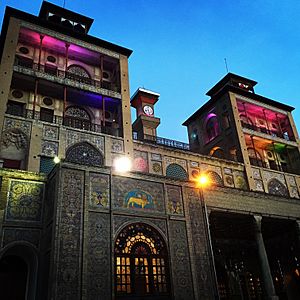
The Niavarān Palace Complex is a historical site in northern Tehran, Iran. It has several buildings and a museum. The main Niavaran Palace was finished in 1968 and was the home of the last shah, Mohammad Reza Pahlavi, and his family until the Iranian Revolution.
Israel/Palestine
In ancient times, palaces existed in the land that is now Israel and Palestine. For example, the site of Tel Kabri had a palace core around 1600 BCE. The Hebrew Bible mentions palaces of kings like Solomon and David, but their exact locations haven't been found.
In Roman Judaea, palaces of the Herodian kings have been found, including a main palace in Jerusalem and a winter palace at Herodium. Herod's palace at Caesarea Maritima was also used by Roman governors.
Lebanon
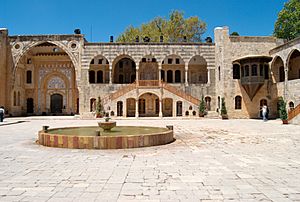
Palaces have been in Lebanon since the time of the Phoenicians. Most ancient Phoenician palaces have been destroyed. During the Renaissance, many palaces were built in Lebanon, especially in the Chouf region. Lebanese palaces have a mix of styles, influenced by Arab, Italian, French, Persian, Turkish, and East Asian designs. The Beiteddine Palace is a good example of this mix.
Today, Lebanon has at least ten buildings that are considered palaces, including the Beiteddine Palace, Grand Serail, and Baabda Palace.
Malaysia

In Malaysia, a palace is called an istana. Malaysia has nine states ruled by sultans, and one of them is chosen every five years to be the Yang di-Pertuan Agong (Supreme King). Each sultan has their own istana in their state.
The Yang di-Pertuan Agong's official homes are the Istana Negara, Jalan Duta and Istana Melawati in Putrajaya. The old Istana Negara, Jalan Istana is now a Royal Museum.
Nepal
Singha Durbar (meaning Lion Palace) in Kathmandu is the official government building of Nepal and one of the largest palaces in Asia.
The Narayanhiti Palace Museum was the home and workplace of the King of Nepal. It was built in 1961. After a revolution in 2006, this royal palace became a public museum.
Older palaces include the Durbar Squares, which are UNESCO World Heritage Sites. These are located in the Kathmandu Valley in Kathmandu, Bhaktapur, and Lalitpur.
Kathmandu Durbar Square was the royal palace area for the Malla and Shah kings. It has amazing architecture and shows the skills of Newar artists. Part of it was damaged in an earthquake in 2015.
Bhaktapur Durbar Square is another UNESCO World Heritage Site. It's in the town of Bhaktapur, east of Kathmandu. This palace is known for its "55 Windowed Palace."
Patan Durbar Square is in the city of Lalitpur. It's also a UNESCO World Heritage Site and has an ancient royal palace where the Malla Kings lived. The square is tiled with red bricks and has many temples.
Philippines
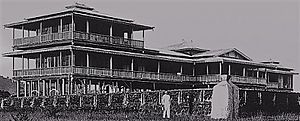
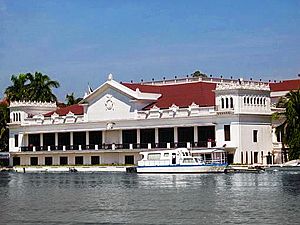
Before the Spanish arrived in the Philippines, Filipinos built large wooden homes for their nobles called Torogan or Bahay Lakan ("king's house"). These homes had unique designs, like high roofs and carved wood.
In the southern Philippines, groups like the Tausug built wooden palaces. The Sultanate of Sulu had a palace called Astana Darul Jambangan, which was destroyed by a typhoon in 1912.
During the Spanish Era, the Spanish government built palaces in and around Manila. The most famous is the 18th-century Malacañang Palace. It was home to Spanish and American governors and is now the home of the President of the Philippines.
The Coconut Palace was built in 1978 to show how coconuts could be used. It's now the home and office of the vice-president.
Europe
Belgium
The Gruuthusemuseum in Bruges is a museum of old arts. It's located in the medieval Gruuthuse, which was the palace of Louis de Gruuthuse. This building was originally a storage place for "gruit" (an herb mix for beer) in the 1200s. In the 1400s, it was turned into a fancy home.
France
In France, there's a difference between a château and a palais. A palais is always in a city, like the Palais de la Cité in Paris, which was once the royal palace and is now France's supreme court. A château, however, is always in the countryside, even if it's no longer a fortified castle.
For example, the "Palace of Versailles" is called that in English because the king lived there. But in French, it's always been the Château de Versailles. The main government building in Paris was the Palais du Louvre.
Germany
In Germany, the word for "palace" is Palast, used for very large palace complexes and gardens. Large country homes are usually called schloss (which can mean "chateau" or "castle").
Germany has over 25,000 castles and palaces! Many of these buildings are very old, some over 1000 years. After the Middle Ages, many German castles were built more as royal palaces than as fortified buildings. Famous examples include Sanssouci, Linderhof Palace, and Schwerin Palace.
Greece
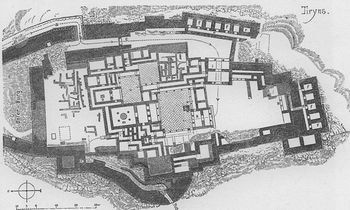
The best examples of Bronze Age palaces in Greece are found at Mycenae, Tiryns, and Pylos. These were important centers for administration. They were built around courtyards with many different rooms, like storage areas, workshops, and living spaces. The main part of the palace was the megaron, which was the throne room. Palaces often had two stories, with the royal family's private rooms upstairs.
Hungary
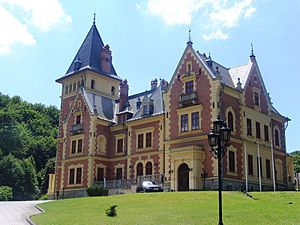
In Hungary, city homes of important nobles were called palota (palace). Country homes were called kastély (mansion). The office of the President of Hungary, Sándor Palace, was once the home of the Sándor family. Royal homes were also called palaces, like Buda Castle. In the late 1800s, many grand new city homes in Budapest were also called palaces.
Italy
In Italy, any grand city home is called a palazzo. These were often owned by wealthy families, not just nobles. In the Middle Ages, these buildings also served as warehouses and businesses. Each family's palazzo was a busy place where all family members lived and worked.
Bishops' city homes were always palazzi. Many former capital cities have a Palazzo Ducale, which was the home of the local duke. In Florence, the government building was called Palazzo della Signoria (now Palazzo Vecchio).
Historically, the ground floors of palazzi were often used for shops and offices, open to the public. The fanciest floor, called the piano nobile, was for the family.
The most important royal palazzi in Italy are in Caserta, Naples, Palermo, Turin, and the Quirinale Palace in Rome.
Malta
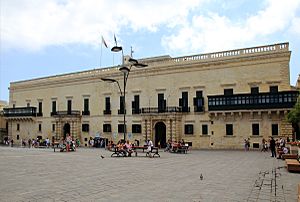
Before the 1500s, Malta was part of the Kingdom of Sicily, and its capital Mdina had many palaces for nobles. When the Order of Saint John arrived in 1530, they used part of Fort St Angelo as a palace for their Grand Master.
When the new capital Valletta was built in 1566, a new Grandmaster's Palace was constructed. The knights also lived in large houses called auberges, which were like palaces. The Auberge de Castille is an important one, now home to the Prime Minister of Malta. The Grand Masters also built country homes like Verdala Palace and San Anton Palace, which are now official homes for the President of Malta.
Poland
The old Kingdom of Poland, called the Polish–Lithuanian Commonwealth, was very large. This allowed nobles to build grand homes. Polish nobles loved Baroque and Rococo styles. Many famous palaces were designed by architects like Tylman van Gameren.
Today, Poland has hundreds of palaces in different styles. Some famous ones include Wilanów Palace, the Presidential Palace in Warsaw, and Branicki Palace. Some palaces look like medieval castles, such as Moszna Castle and Książ Castle.
Portugal
Most of Portugal's palaces were once royal homes. Some examples include Mafra National Palace, Pena National Palace, Belém Palace, and Ajuda National Palace. The Pena National Palace in Sintra, Portugal is famous for its colorful, romantic style.
Romania
Palaces in Romania were built for royalty, nobles, and bishops. Three former royal palaces are the Cotroceni Palace (now the President's home), the Royal Palace in Bucharest (now a museum), and the Elisabeta Palace. Even though Romania is no longer a monarchy, Princess Margareta still lives at Elisabeta Palace.
Other palaces include the Crețulescu Palace and Peles palace, built by King Carol I of Romania.
The Palace of the Parliament in Bucharest and the Palace of Culture in Iași are huge government buildings. The Palace of the Parliament is one of the largest buildings in the world.
Russia
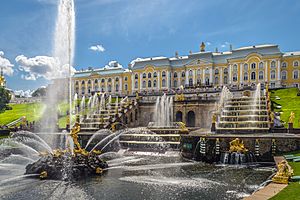
The first palaces in Russia were built about a thousand years ago for the Grand Dukes of Kiev, but they were destroyed. The first European-style palaces were built during the time of Tsar Peter the Great.
Famous Russian palaces include:
- The Palace of Facets (1487–1491) in the Kremlin.
- The Kolomensky Wooden Palace (1528—1532).
- The Terem Palace (1635–1636) at the Kremlin.
- The Menshikov Palace (1710—1727) in Saint Petersburg.
- The Peterhof Palace (1709—1755) in Petergof, known for its beautiful fountains.
- The Winter Palace (1732–1917) in Saint Petersburg, which was the official home of the Russian monarchs.
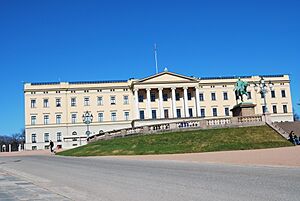
Denmark, Norway, and Sweden all have long histories with kings and queens, and they have many palaces.
In Denmark, Christiansborg Palace in Copenhagen was a royal palace, but now it's mostly used for royal events. Amalienborg Palace has been the Danish royal home since 1794.
In Norway, the Royal Palace in Oslo has been the royal home since 1849.
In Sweden, the large Stockholm Palace was built in 1760 and is still the official royal home. However, the Swedish royal family usually lives in the smaller Drottningholm Palace.
Serbia
The two royal families of Serbia, Karađorđević and Obrenović, built many homes. The most important official palaces are the Stari Dvor and the Novi Dvor (Old and New Court) in Belgrade. The Royal Compound in the Belgrade suburb of Dedinje includes the Beli Dvor and Kraljevski Dvor (Royal Palace).
Spain
Spain has over a thousand years of royal history, so it has many palaces built for different monarchs and nobles. The Royal Palace of Madrid, also called Palacio Real, is the largest palace in Europe with over 2,800 rooms. However, the royal family now lives in the smaller Palacio de la Zarzuela.
Other famous Spanish palaces include the Alcázar of Seville (which mixes Moorish and European styles), the Alhambra, and the Monastery of San Lorenzo de El Escorial.
United Kingdom
In the United Kingdom, only official homes of the royalty or bishops are called "palaces." For example, Buckingham Palace was called Buckingham House before it became a royal residence.
Blenheim Palace is one of the few non-royal homes to have "palace" in its name. It was given to a great general, the Duke of Marlborough, as a special honor. Windsor Castle is another famous royal palace.
Turkey
After Istanbul was conquered in 1453, the Topkapı Palace was built between 1460 and 1478. It's a huge area of 700,000 square meters. For almost 400 years, Topkapı Palace was the main center for the Ottoman Empire's government, education, and art.
In the mid-1800s, the Ottoman rulers moved to the Dolmabahçe Palace, but Topkapı Palace remained important. After Turkey became a republic, Topkapı Palace was turned into a museum on April 3, 1924. It's one of the largest palace-museums in the world.
Other Palaces
In Continental Europe, royal and bishop's palaces were not just homes; they were also where government officials worked. Today, many bishops' palaces still have both their living areas and their offices.
The Palace of the Parliament in Bucharest, Romania, is the largest palace in the world. It was built during the socialist era and is a massive building.
The Palace of the Olowo, the ruler of the Yoruba Owo clan in Nigeria, is known as the largest palace in all of Africa. It has over 100 courtyards, each with a special traditional use.
Images for kids
-
The Forbidden City in Beijing, China.
-
The Tokyo Imperial Palace, the official home of the Emperor of Japan.
-
The Blue House, the official home of the President of South Korea.
-
Istana Negara (National Palace), the official home of the king of Malaysia.
-
The Planalto Palace, in Brasília, Brazil.
-
The Palacio Nacional, or National Palace in Mexico City, built as the home of the Viceroys of New Spain in 1563.
-
Tigran Honents Palace in Ani.
-
Ahsan Manzil, Dhaka.
-
Drone view of the Shenyang Imperial Palace.
-
Golestan Palace in Tehran.
-
Map of Tiryns palace.
See also
 In Spanish: Palacio para niños
In Spanish: Palacio para niños


